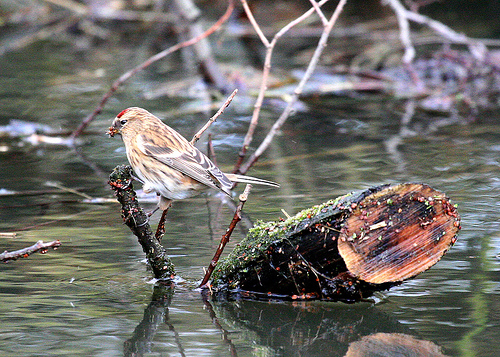- Lesser Redpoll
Taxobox
name = Lesser Redpoll

image_width = 250px
image_caption =
regnum =Animal ia
phylum = Chordata
classis = Aves
ordo = Passeriformes
familia = Fringillidae
genus = "Carduelis "
species = "C. cabaret"
binomial = "Carduelis cabaret"
binomial_authority = (Statius Müller, 1776)
synonyms = "Carduelis flammea cabaret"
"Acanthis flammea cabaret"
"Acanthis cabaret"The Lesser Redpoll, "Carduelis cabaret", is a small
passerine bird belonging to the genus "Carduelis " in thefinch family, Fringillidae. It is the smallest, brownest and most streaked of theredpoll s. It is often classified as asubspecies of theCommon Redpoll , "Carduelis flammea", but has recently been split from that species by several authorities such as theBritish Ornithologists' Union . It is native toEurope and has been introduced toNew Zealand . Many birds migrate further south in winter, but the mild climate means that it can be found all year round in much of its range, and may be joined by the other two redpoll species in winter.Taxonomy
The relationships among the redpolls are unresolved. [Seutin "et al.", 1995] The Lesser Redpoll co-occurs with the Mealy Redpoll (subspecies "flammea" of the Common Redpoll) in southern
Norway , apparently without significant interbreeding thoughsympatry was established too recently to draw firm conclusions. [Sangster "et al.", 2002]Description
It is a small, short-tailed finch, 11.5-12.5 centimetres long with a wingspan of 20-22.5 centimetres and a weight of 9-12 grams. The bill is short, conical and sharply pointed and is pale yellow with a dark tip. The adult male is largely brown above with darker streaks. It has a red forehead, a black chin and, during the breeding season, pink on the breast and face. The flanks are buff with dark streaks and the belly and undertail-coverts are whitish. There are two pale bars on the wing. The adult female is similar but lacks the pink on the breast and face and has less streaking on the flanks. The juvenile has a pale head with no red forehead and less black on the chin.
The commonest call is a harsh, metallic, staccato "chuch-uch-uch-uch" given in flight or while perched. It also has a plaintive alarm call. The trilling song combines the flight call with a buzzing rattle and is often given in an undulating song-flight around the territory..
The Mealy Redpoll is similar to the Lesser Redpoll but larger and paler with whiter underparts. The upperparts are more buff and the rump is pale with dark streaks.
Distribution and habitat
It was formerly almost restricted to
Great Britain ,Ireland and theAlps but its range has expanded considerably across central and northern Europe in recent decades. It is a widespread breeding bird in Britain and Ireland although absent from parts of southern and centralEngland . It nests along theNorth Sea coast from north-eastFrance toGermany and has spread intoDenmark , southernNorway and south-westSweden . The Alpine population has increased and spread into neighbouring regions. The bird now nests as far east as southernPoland ,Slovakia and northernRomania .It is a short-distance migrant with many birds spending the winter within the breeding range. Alpine birds often move to lower elevations. In Britain, it becomes more widespread in lowland areas in winter. Some British birds move south to mainland Europe, occasionally reaching as far as Iberia.
This species was first introduced to New Zealand in 1862 as part of shipment of birds to Nelson. [cite web|title=Redpoll|date=
2005-09-21 |url=http://www.nzbirds.com/birds/redpoll.html|work=NZ Birds website|accessdate=2007-10-09] Several further introductions followed and it has become widely established. It is most common on theSouth Island and at higher altitudes and has colonised many offshore islands. It has spread to theAustralia n territory ofMacquarie Island and has occurred as a vagrant toLord Howe Island .It inhabits open
woodland ,scrubland ,farmland anddune s. Its spread has been aided by an increase inconifer plantations.Behaviour
It is a sociable birds which usually forages in flocks. It mainly feeds in trees but also feeds on the ground, especially in winter as the supply of
seed s becomes reduced. The diet is mostly composed of small seeds such as those ofbirch ,alder andgrass es.Fruit bud s andinvertebrate s are also eaten.Breeding pairs form in late winter. The breeding territory and several pairs will often nest close together in a loose colony. The cup-shaped nest is built by the female, usually in a shrub or tree. It is made of twigs and plant stems with an inner layer of roots, grass, moss, leaves and other vegetation and a lining of feathers, wool and hair. Two to seven eggs are laid. They are pale bluish or greenish with reddish or brownish blotches and streaks. The female incubates the eggs for 12-15 days while being fed by the male. The young birds are fed by both parents and
fledge after 9-15 days.References
* Clement, Peter; Harris, Alan & Davies, John (1993) "Finches and Sparrows: An Identification Guide", Christopher Helm, London.
* Harris, Alan; Tucker, Laurel & Vinicombe, Keith (1994) "TheMacmillan Field Guide to Bird Identification ", Macmillan Press.
* Heather, Barrie D. & Robertson, Hugh (1996) "The Field Guide to the Birds of New Zealand", Viking.
* Robinson, R.A. (2005) [http://www.bto.org/birdfacts/results/bob16634.htm BirdFacts: profiles of birds occurring in Britain & Ireland] (v1.1, Jan 2006). BTO Research Report 407, BTO, Thetford (http://www.bto.org/birdfacts). Retrieved on 23/10/07.
* Sangster, George; Knox, Alan G.; Helbig, Andreas J. & Parkin, David T. (2002): Taxonomic recommendations for European birds. "Ibis" 144(1): 153–159. DOI|10.1046/j.0019-1019.2001.00026.x [http://www.blackwell-synergy.com/doi/pdf/10.1046/j.0019-1019.2001.00026.x PDF fulltext]
* Seutin, G.; Ratcliffe, L. M. & Boag, P. T. (1995): Mitochondrial DNA homogeneity in the phenotypically diverse redpoll finch complex (Aves: Carduelinae: "Carduelis flammea - hornemanni"). "Evolution" 49(5): 962–973. DOI|10.2307/2410418 (HTML abstract and first page image)
* Snow, D. W. & Perrins, C. M. (1998) "Birds of the Western Palearctic: Concise Edition", Vol. 2, Oxford University Press, Oxford.
Wikimedia Foundation. 2010.
